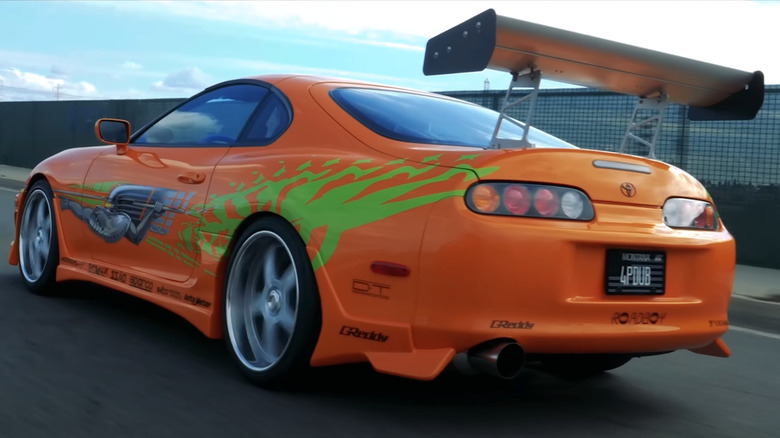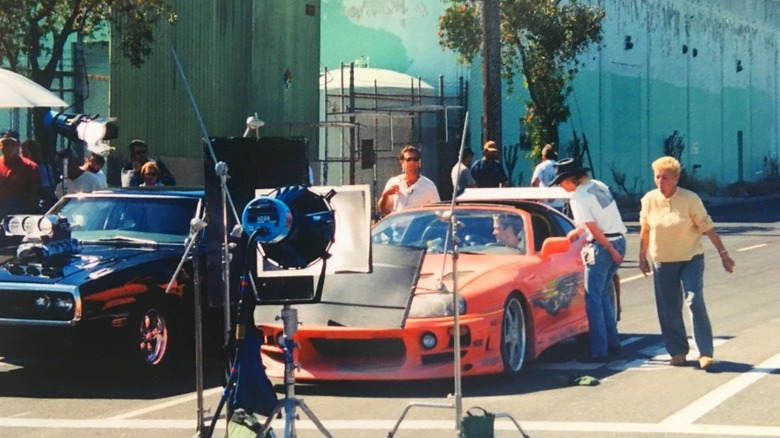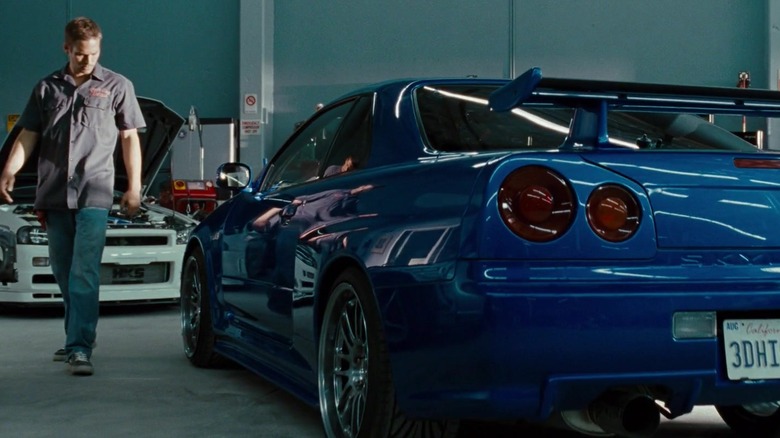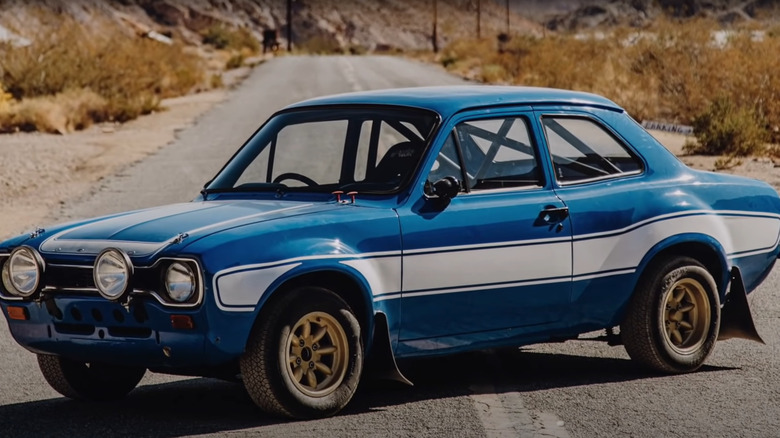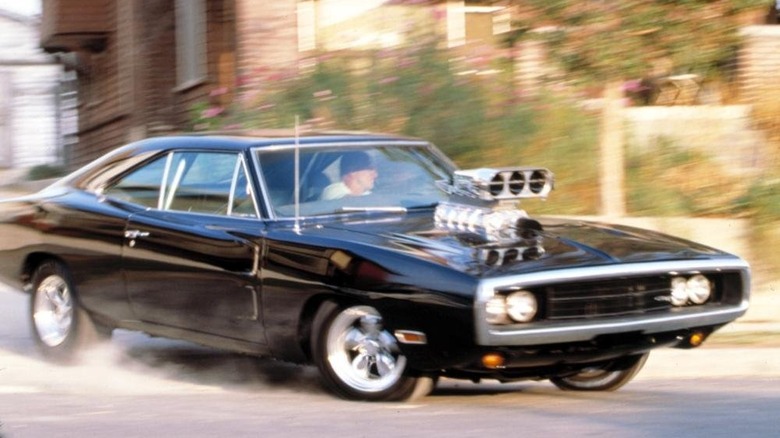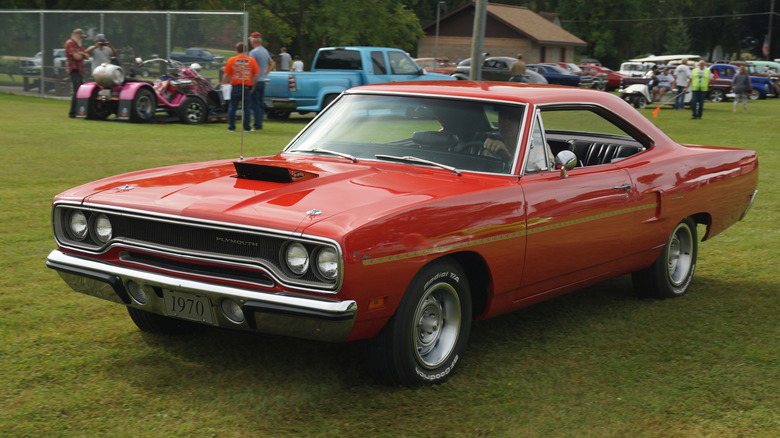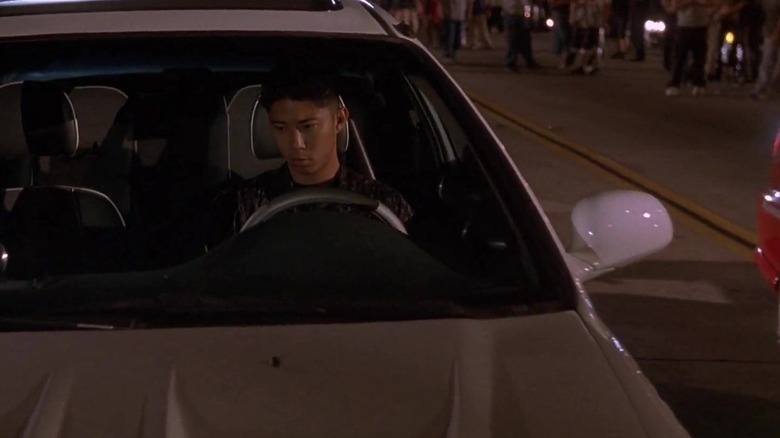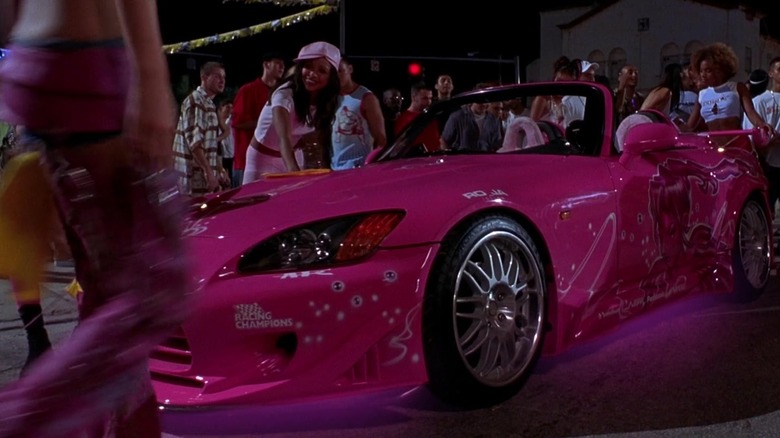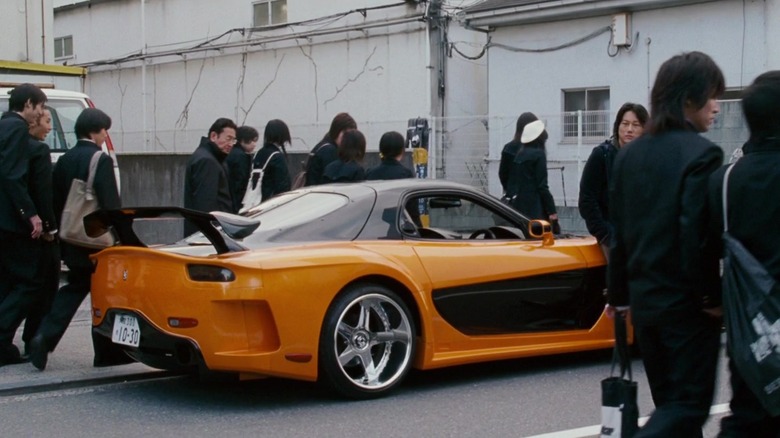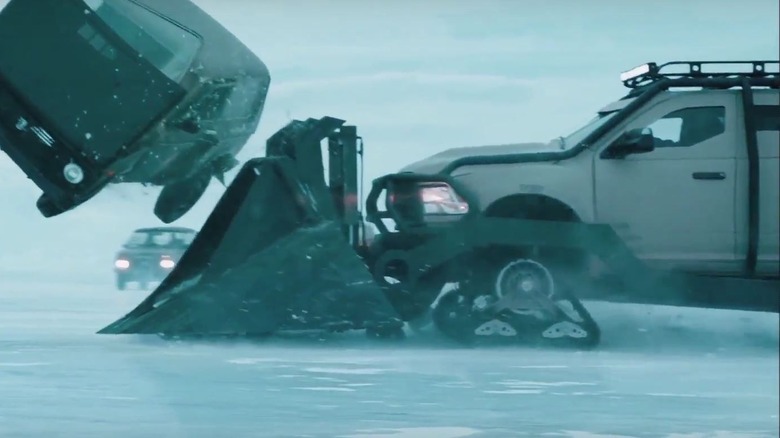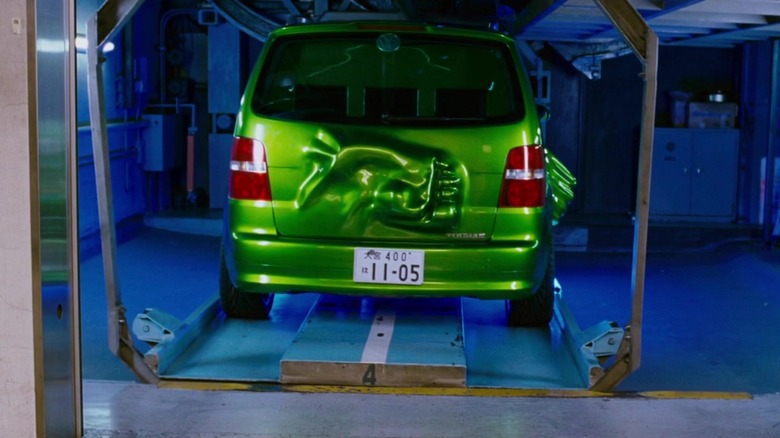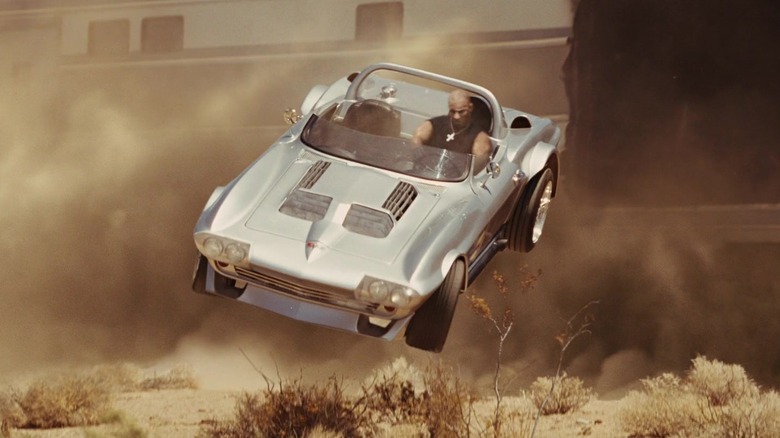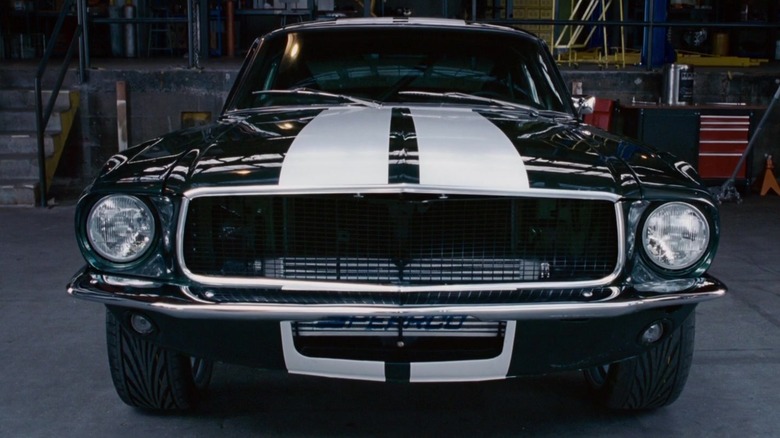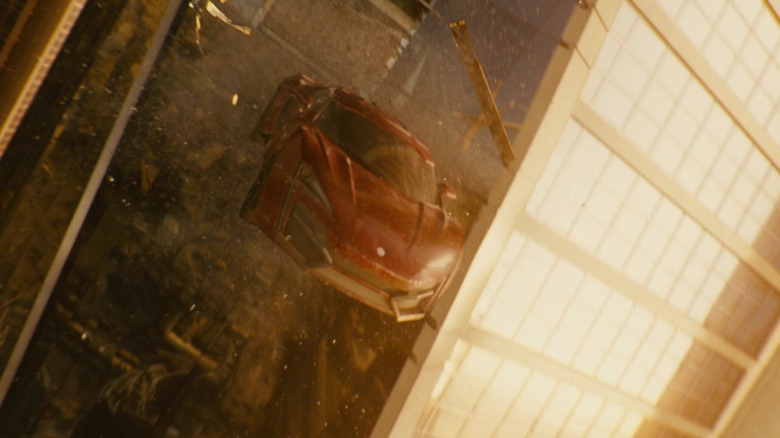What Really Happened To Fast & Furious' Most Iconic Cars
Ever since 2001's "The Fast and the Furious" brrap psst'ed onto theater screens and into our hearts, the franchise has become one of the biggest in Hollywood history. Right from the starting line, the movies have shown the best parts of car tuner culture, with high-octane action, deeply customized imports, and the friends, families, and parties from the car scene. As the franchise evolved, it encompassed all aspects of car culture, including classics, sleepers, utility vehicles, and some of the best-armored people carriers available to law enforcement.
The series appeals to normal moviegoers through the approachable, likable main characters, who show that family isn't just all about blood. Gearheads find a different appeal in the hundreds of high-end, suped-up cars, trucks, and luxury vehicles that feature prominently in nearly every scene. The "Fast and Furious" franchise has seen the best of the best, from Japan Domestic Market (JDM) imports tricked out in copious amounts of neon glow to hypercars and other limited-run vehicles.
Movie filming schedules are notoriously hard on the vehicles they use. Every car driven by a main character will have one fully-customized 'hero' vehicle used for exterior and interior shots and close-ups. There's often a backup hero vehicle and multiple copies that look the part from the outside, which are used for any stunts. With filming being hard on the vehicles, it's a wonder any of them survive past the production. But survive, they do, and we've found out where some of the most iconic cars from the franchise ended up.
Brian's Toyota Supra Mk-IV
Eight orange Supras were used in 2001's "The Fast and the Furious" throughout the filming. One was the hero car with modified engine parts, one was a backup for the main car but only on the outside, and six were stunt doubles. This is the 10-second car that Brian owed Dom, the wheels that set the franchise up for its never-ending road race. The 1994 Supra cost $24,000 new and received extensive customizations to almost every part of the car. The engine was filled with custom parts from Greddy, HKS, Turbonetics, and NOS, bringing 544 – 569 horsepower before nitrous (the range is because it was tested on two dynos, with differing results). The exterior got a makeover with that sweet neon orange and custom Troy Lee graphics, the tires and suspension got upgraded, the interior was decked out in carbon fiber and blue suede, and a roll cage was added.
The original was owned by Craig Lieberman, technical advisor on the first two movies, and had achieved modest success at car meets before its catapult to stardom. He kept hold of it for a year after the movie but got an offer he couldn't refuse from a private collector in the Netherlands. The hero car with its modifications was sold for a tidy $185,000 profit. Four of the stunt cars received a gold exterior for the sequel. Two of those were returned to the orange livery and went on to be sold at auction to private collectors, one for $185,000 in 2015 and one for $550,000 in 2021.
Brian's Nissan Skyline GT-R R34
The one-off Nissan Skyline GT-R R34 built for the fourth installment, "Fast & Furious," was supposedly Paul Walker's favorite car to drive in the entire series. Built by Daryl Alison of Kaizo Industries, the Bayside Blue Skyline was unblemished by the usual decals of manufacturers used in the customization at the behest of Paul Walker, who didn't want to drive a "sticker bomber." The production team also built another eight Skyline copies for stunts and other filming needs from ER34 body shells on top of a Volkswagen Beetle chassis.
What's possibly more infamous than one of the late Paul Walker's favorite cars is the story around the importation of the Skyline. In 2010, a former Orange County Sheriff's deputy pleaded guilty to a misdemeanor for illegally importing Japanese Domestic Model cars. One was the Skyline GT-R R34, and the deputy was no other than Daryl Alison. The U.S. Immigration and Customs Enforcement (ICE) investigated the case. They said that Alison brought the cars in disassembled, put them together at his now-defunct business premises, and put fake VINs onto them before the sale.
The Skyline was eventually released from federal lockup and has gone through several owners. The latest owner is GT-A International, an auction house based in Munich, Germany, currently auctioning off the 1-of-1 Bayside Blue Skyline GT-R R34 with an appraisal range between 750,000 and 5,000,000 Euros.
Brian's Mark I 1972 Ford Escort RS1600
For "Fast and Furious 6," the producers wanted to bring cars from more nations into the mix. Two British-made cars were pulled into the lineup for this sixth movie outing, a 1971 Jensen Interceptor driven by Letty and this third classic car driven by Brian – a Mark 1 1972 Ford Escort RS1600. Thanks to Craig Lieberman, we know how the producers sourced and built the cars used for one of the biggest stunts in the movie. All five of the Ford Escorts built for filming had to be purchased in the U.K., as none of the Mk 1 Escorts that made it to the U.S. fit the necessary specifications. Some had period-correct 1.6-liter Ford Kent engines with DOHC Cosworth heads and double Weber carbs, while others had 2.0-liter Vauxhall Redtop engines from Opel, with all five rebuilt in the U.K.
Two of the five were stripped to be used in the bridge jump scene during the tank chase sequence. One of the jump cars was written off immediately after flipping while the first half of the jump was filmed. The second jump car survived but was a twisted wreck left in storage for many years. A British collector bought the mangled chassis and spent the equivalent of $90,000 in British pounds restoring it to its former glory.
Dom's 1970 Dodge Charger
Oh boy, Dom's Charger is almost synonymous with the Fast franchise, popping up every few movies. Originally built by Toretto and his father, the big-block beast had been sitting in the garage with Dom unwilling to drive it as his father had an accident in it. That's until the last few minutes of "The Fast and the Furious," when it revved up for a pedal-to-the-metal drag race vs. Brian's iconic 1994 Honda Supra. That race ended up with a bad end for the 1970 Dodge Charger, but it was rebuilt for "Fast & Furious," "Fast Five," and "Furious 7." The supercharged 1970 Dodge Charger R-stroke-T is returning for the upcoming "Fast X," with the trailer showing it in a drag race against the new villain, then dropping out of a cargo plane before it crushes two cars and makes two helicopters blow up.
The thing is, according to Craig Lieberman, the 1970 Dodge Charger wasn't a 1970 but one from 1969, as they had trouble sourcing the correct year. The production team tweaked it so it looked like 1970 from the outside, but it wasn't. The engine wasn't an original either, with Lieberman saying it was borrowed from Chuck Taylor's Racing Engine. The team swapped the rumored 900 horsepower engine back out for the road driving scenes, using a big-block 440 Magnum engine. That engine is still in the car, where it is on display at Volo's Auto Museum.
Letty's Plymouth Roadrunner
The Torettos love some Mopar action, with every Fast franchise installment featuring at least one Dodge muscle car. They also have a lot of love for their cousins at Plymouth, showing that their love for family extends to steel and chrome. The gray 1970 Plymouth Roadrunner first shows up at the end of "Fast and Furious: Tokyo Drift," bringing a short cameo from Dom Toretto, bringing him back to the series. Skip a few installments ahead, and the same Roadrunner appears in "Furious 7" concurrent with "Tokyo Drift's" timeline. The gray Roadrunner is next in "Fast & Furious," being driven by Letty Ortiz while she is working for a Mexican cartel. Two Plymouth Satellites were made to look like Roadrunners for the stunts in the movie.
They also had a backup Roadrunner, which was the stunt car from "Tokyo Drift." Between the scene where Letty's car gets flipped with her inside, and the other stunts, both Satellite cars were totaled. The second stunt car survived unscathed, as the team nailed the stunt in one take. Jamie Vickers, a Hollywood production designer, now owns the restored 1970 Plymouth Roadrunner, which he bought as one of the two stunt cars from "Fast & Furious." It's been resto modded to feature over 760 horsepower from a custom, bored-out big block 426 Hemi.
[Featured Image by Greg Gjerdingen via Wikimedia Commons | Cropped and scaled | CC BY 2.0 ]
Danny's Honda Civic
The white Honda Civic from the first race in the first "The Fast and the Furious" movie is a classic; who would forget the driver playing "Gran Turismo" on his in-dash entertainment system before the race? That driver, Danny Yamato, was none other than R. J. de Vera, now currently the Vice President of Marketing of the Specialty Equipment Market Association (SEMA). He was one of the people that Universal Studios picked to help launch the "Fast and the Furious" franchise, helping with car and tuner part selection for the main characters. Having a cameo part in one of the most iconic 4-way drag races is a fun thing to put down on his resume, and coming second behind Dom Toretto is no mean feat.
This iconic Civic is now owned by The Furious Garage, which owns a handful of the most well-known Fast & Furious vehicles. The Furious Garage needed this Civic to complete the set of all four cars driven in that drag race. They already owned one of the RX-7s that Vin Diesel drove, "Monica," the iconic Acura Integra, and one of the stunt Mitsubishi Eclipses that Paul Walker drove.
Suki's Honda S2000
Suki, played by Devon Aoki, had one of the most instantly-recognizable cars in the whole franchise. The hot pink Honda S2000 with an airbrushed paint job and neon under glow is every bit as loud and fiery as the character who drives it. It was also part of one of the biggest stunts in "2 Fast 2 Furious," with an insane bridge jump during a four-way road race. The stunt car was a replica of the actual S2000 and only suffered minor radiator and bodywork damage. It also featured in "The Fast and the Furious," in a more subdued paint tone. When it appeared in the first movie, the S2000 was driven by villain Johnny Tran and had jet-black paintwork. The car was owned by R. J. de Vera at that time, and it was rented by the production. The producers bought it outright between the two movies and turned it into the hot pink princess-powered rocket in the second movie outing.
The Honda S2000 from "2 Fast 2 Furious" currently resides in the Petersen Automotive Museum in Los Angeles, California, where anyone can go and see it and take pictures. That's a fitting end for one of the most outlandish paint jobs that any car in the "Fast & Furious" franchise sped across our screens wearing.
Han's Mazda RX-7
The Mazda RX-7 driven by Han Lue in "The Fast and the Furious: Tokyo Drift" was already a JDM icon before the movie. VeilSide created the specific hero car from the movie, using it as a showcase vehicle for its newest widebody kit for the stock RX-7 FD. Originally in red instead of the eye-catching orange, VeilSide was showcasing its skills for car shows. It sounds like a perfect car to showcase in the biggest car franchise in movies, and it was, stealing the show at the 2005 Tokyo Auto Salon before it wheeled onto the screen. The stock RX-7 costs $29,528 new, and the Fortune body kit costs almost $16,000. The configuration shown in "Tokyo Drift" came with carbon fiber body panels which would have pushed the cost over $20,000. While the in-show car got flipped and blew up, that was thankfully a clone stunt vehicle.
After filming finished, both of the RX-7 models used were shipped back to Japan, as the 25-year import rule precluded them from staying in the U.S. Two were eventually bought by UK dealership Newera Imports, with one being sold to a "well-known Australian sports car collector."
Hobbs' Ice Ram
The eighth outing for the franchise, "The Fate of the Furious," took the team globe-trotting before culminating in a race across the ice toward a Russian nuclear submarine. Dom has gone rogue, but everyone, including the viewer, is in the dark as to why until the final scenes. Dwayne Johnson reprised his Luke Hobbs role, known for his larger-than-muscle cars, which echo his physical stature. For the furious driving over ice, Hobbs' had a specially modified Dodge Ram that instantly joined the ranks of some of the wildest vehicles from the franchise. Instead of wheels, the Ice Ram has four triangular tank tracks, one on each corner. The tracked terror also had a huge ram, which could flip down in front of the Ram for flipping, well, anything in front of it.
The Ice Ram was an off-the-showroom Dodge Ram, with Mattracks' 150M1A2-SAs instead of wheels. While we're not sure what became of the Ice Ram used in "F8," anyone can have one in their garage as the company who created it sells conversions to consumers.
Twinkie's Volkswagen Touran
One of the cars in "The Fast and the Furious: Tokyo Drift" is unmistakable not for the speeds it can reach or its drifting prowess but for the undeniable style permeating every inch of it. That's the Hulk-themed 2005 Volkswagen Touran owned by Twinkie, played by Bow Wow. The Touran holds a beast inside with dents of Hulk-sized fists and feet, looking like they are trying to break out of the bodywork. The interior is filled with purple fuzz, with a hefty multimedia system including multiple subwoofers and television panels. Director Justin Lin was behind its creation, inspired by the old "The Incredible Hulk" TV episode when the big green ball of incandescent rage is captured and driven across the city in a van, which it busts out from.
The Hulk-ified Volkswagen Touran was parked in Universal Studios in Orlando, Florida, as part of the promotional efforts between the carmaker and the production studio. It was no random parking spot; right next to The Incredible Hulk Coaster, which zooms riders at up to 67 mph through seven inversions and two subterranean trenches.
Dom's 1963 C2 Corvette Grand Sport
The opening heist of "Fast Five" has Mia, Vince, Brian, and some accomplices stealing three cars from a train outside Rio de Janeiro. Those include a Ford GT40, which later drives the plot further by containing a computer chip with details of a wide-ranging criminal organization, a De Tomaso Pantera GTS, which overheats in 75f weather and is one of the rarest cars in Elvis Presley's collection, and one even-rarer vehicle, the 1963 C2 Corvette Grand Sport. This rarest of Corvettes had only five cars built, and they are all owned by private collectors that wouldn't part with their unicorn 'vette. The five prototypes were built to compete at Le Mans, but General Motors canceled the project and wanted to trash the prototypes. The chief engineer, Zora Arkus-Duntov, sold them to private buyers before that happened, preserving a piece of racing heritage that never made it to the track.
For "Fast Five," the production team turned to replica maker Mongoose Motorsports. Twelve 1963 clone C2 Corvettes were produced with custom tubular chassis, air-cooled Volkswagen engines, knock-off wheels, and coilover suspension. The filming was hard on these cars, considering they needed to be jumped to create the stunt. Only three are known to survive, with Volo Auto Museum having the best-preserved version, as it was the one used for close-ups and was mounted to a rig in front of a green screen. The same Corvette Grand Sport went up for auction in April 2021, but Volo still lists it in their inventory, so maybe the sale was called off. If you want your own, Mongoose Motorsports is an officially licensed GM manufacturer and sells the Grand Sport for under $100,000.
Sean's 1967 Ford Mustang With an RB26 Engine Swap
The classic hero car from the last race of "The Fast and the Furious: Tokyo Drift" was owned by Sean Boswell (Lucas Black)'s father, but it needed a new engine. When in the land of the rising sun, only the best JDM engine will do, and an RB26 out of a Nissan Skyline GT-R gave the 1967 Mustang some kick. Sean and his friends put the frankencar together so that it could drift its way to victory, making Sean the Drift King. The tweaked Mustang was better than either the donor Skyline or the Mustang, with 340 horsepower and faster speeds than either of the original cars, with 13 mph more on its top speed.
Six cars were produced for the movie, with one being totaled during filming. The other five were sold off by Universal, going overseas and to local auction lots. The Hero 1 car with the RB26 swap ended up at Volo Auto Museum, where it says it has been sold, presumably to a private collector.
Lykan Hypersport
The insane hypercar built by Lebanese automaker W Motors costs upwards of $3.4 million, with headlamps that use real diamonds and rubies. 420 15-carat diamonds are inset in the titanium LED blades of the lights, and the roof is gold-plated. Truly a luxury of luxuries for a hypercar that still only has seven production models. As noted by Gulf News, one of those seven is owned by Vin Diesel, added to his already impressive collection of cars.
In "Furious7," the Lykan Hypersport was a major plot point, holding a computer chip the team needed to go in and steal. The scene ended with the Lykan jumping between the Etihad Towers before falling to destruction. The hypercar used for the close-ups wasn't used in the stunts. Maybe that's the one Vin Diesel now owns. W Motors made ten replica cars for the production team, with TopGear reporting they used 300 horsepower Porsche Boxter engines. One of the ten replica cars built by W Motors for the stunt in Furious7 is still hanging in W Motoer's showrooms as a showpiece. The other nine didn't survive the filming.
